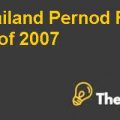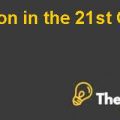
INTRODUCTION AND BACKGROUND
Export-Import Bank of United States (EX-IM) is the U.S.’s official credit export agency (ECA) tasked with providing financing for exports to create and sustain employment in the country, especially at times when private financing is constrained and terms are negative for businesses with major exports. In 1945, EX-IM became an independent U.S. government agency through the Export-Import Bank Act. During 1980s bank incurred significant losses to ensure competitiveness of U.S. exports however in recent years more prudent financial policies were employed. Exporters were eligible to apply for bank support subject to EX-IM’s U.S. content rules. Congress required EX-IM to support small and medium businesses and provide a minimum 20% of all total authorizations. This was mostly done through working capital loan guarantees and export credit insurance while larger exporters were supported by medium and long-term programs. EX-IM charged upfront facility fee for its services.
Market conditions for trade finance in 2009 were adverse due to the economic crises of 2008 and short-term financing had disappeared due to losses from major banks’ exposure to sub-prime mortgage related securities and investments. Low availability was coupled with higher costs of finance exacerbating the situation. These were the sort of conditions where EX-IM was needed to inject much needed financing to help businesses with significant exports thus, demand for bank’s services were high.
Emirates, a government-owned limited liability corporation and national carrier of United Arab Emirates was interested to purchase three new aircraft from Boeing and adequate financing arrangement was critical for the deal to succeed. To secure required financing, EX-IM would provide repayment guarantee on $414 million public bond issue for a 3% fee. Transaction was unique as all previous transactions involving EX-IM for aircraft financing had been through bank loans. Securing this deal by provision of required finance was in the best interest of U.S. aircraft industry. Boeing was one of the two major aircraft manufacturers in the world, Airbus being the other that was supported by European ECAs. Therefore, EX-IM had an important role to play to sustain U.S. aircraft exports. Over the years, EX-IM financed numerous deals for aircraft exports resulting in significant exposure to aircraft deals at $33.2 million in FY2009 that was more than total U.S. exports for the year (Exhibit 4). EX-IM’s president and Chairman Fred Hochberg needed to evaluate the opportunity before making a final recommendation.
QUESTIONS
- Should EX-IM participate in the notes issuance that would finance the sale of three 777s to Emirates by guaranteeing the interest and principal payments?
- Evaluate the procedure EX-IM uses to determine the costs of making loan guarantees. Assume the beta of the scheduled payments from Amal to Wells Fargo is 0.2 and that the market risk premium is 5%.
EX-IM PARTICIPATION IN AIRCRAFT FINANCING
EX-IM in the past had financed export of capital items through direct loans at a fixed rate but this mode of operation was falling out of favor in support of loan guarantees on commercial bank loans. Historically, authorizations for aircrafts was attractive as transaction fees were more than overall expected costs. Due to unfavorable market conditions that were restricting availability of finance, there was a significant potential funding gap of $10 billion to $20 billion for the U.S. aircraft deliveries in 2009 and with European ECAs actively supporting Airbus, which is Boeing’s main competitor, EX-IM needed to support U.S. aircraft sector and Boeing thereby protecting jobs and industry in accordance with its charter. Loan guarantee for purchase of three aircrafts by a leading international airline (Emirates) would be an important step to support Boeing ensuring that U.S. maintains competitive edge to cater worldwide aircraft demand.
There were two potential issues with the deal though. First was significant existing exposure of EX-IM to aircraft sales as more deals could increase its risk exposure significantly. This problem was likely to be out-weighted by the necessity to support U.S. aircraft industry and in particular Boeing to ensure that its position as a leading worldwide provider is not threatened by European ECAs supporting Airbus. The other issue was the type of financing for the deal. EX-IM had not previously guaranteed capital market financing instrument therefore the opportunity meant moving in an unchartered territory. None the less, this financial security was fundamentally not that different from traditional bank loan and participation of two major U.S. banks in underwriting syndicate lowered the risk.
Decision was likely to depend on perceived risk of default on the transaction by Emirates through failure to pay either interest or principal amount. However, probability and risk of loss was deemed low as is evident from assumptions in Exhibit 12. An analysis at Exhibit B show that even if the risk materializes and bank incurs a loss of................
This is just a sample partial case solution. Please place the order on the website to order your own originally done case solution.
In autumn 2009, Fred Hochberg, chairman of the Export-Import Bank of the United States (Ex-Im), and his team struggled to find a way to help support the sale of Boeing in the Emirates. Ex-Im responding to the problems in the credit market with an innovative proposal. This event gives students the opportunity to analyze the structure and activities of export credit agency and appreciate the expected costs of the issuance of credit guarantee. "Hide
by C. Fritz Foley, Matthew Johnson Source: HBS Premier Case Collection 21 pages. Publication Date: October 21, 2010. Prod. #: 211032-PDF-ENG












